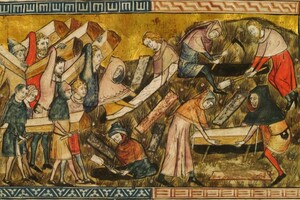Researchers have found the original strain of plague in the remains of Central Asia in the XIV century.

Plague epidemic known as Black death , led to a significant reduction in the world's population seven centuries ago. Despite the fact that the epidemic was so massive, the origin of its causative agent still remains a mystery to scientists. Now researchers have said they have discovered the original strain of the Black Death in 14th-century Central Asia. They studied ancient and modern DNA evidence of the disease and were able to trace the history of its occurrence, according to Discover magazine.
The Black Death raged in Europe, Africa, and the Middle East around 1347-1352. Experts do not agree on how many people died as a result of the epidemic, the number is estimated at 25-200 million victims, ie, killed from 5 to 40% of the world's population.
Read also: Scientists have reconstructed the appearance of a rich Bronze Age
After infection, the plague killed 70 to 80% of carriers, the vast majority of whom died within five days. And these five days they lived in agony. The temperature of the infected jumped, which led to chills, pain and delirium. There were also painful tumors in the lymph nodes called buboes, which secreted pus and burst in the later stages of the disease.
Even after the first wave receded in 1352, the plague continued to return for five centuries, periodically ravaging cities. Despite the fact that the plague was so deadly, the causes of the Black Death remained unclear until the end of the nineteenth century. In 1894, scientists discovered that the plague was caused by a bacterium called Yersinia pestis. This bacterium was transmitted from rats to humans through bloodsucking fleas.
Fleas bit infected rats and ingested bacteria that clogged the flea's intestines and prevented it from eating. Infected, starving fleas raged and jumped from rat to rat, leaving a trail of death and a population of infected insects. As soon as the rat population dwindled, fleas spread to humans, and the deadliest pandemic in human history began.
In search of the original source
But when did the plague spread from rats to humans? This question has puzzled researchers for centuries.
To accurately trace the origins of the plague, scientists have turned to 14th-century archeological sites in Central Asia. Two burials have been found in Kyrgyzstan, the tombstones of which indicate that the victims of the plague of 1338 rest in them. Scientists extracted DNA from the victim's bones and found the DNA of the bacillus E. coli.
That is, the pathogen was already present in Central Asia before it reached Europe. However, researchers have not been able to confirm that this was the original strain of plague. To do this, they turned to the study of “bread crumbs” left in the genome of the bacterium.
When Y. pestis passed from rodents to humans, its genome quickly mutated and diversified – scientists called the event the Big Bang. Small changes in the nucleotides A, C, G and T that make up the genome accumulated and eventually led to the Black Death. By looking at different variants of the plague, researchers can determine what the ancestral strain looked like, which researchers believe they were able to detect.
This strain is very similar to modern strains found in marmots living near archaeological sites. excavations. Probably, these animals “hid” inactive versions of the bacterium between outbreaks of plague. The similarity between the genome of the bacterium found in the burial and in animals indicates that humans became infected with the plague immediately after the bacterium passed from rodents to humans.
According to scientists, this indicates that Black death comes from Central Asia.




